The Astringent Skin Care Products Market is expected to record a valuation of USD 3,205.1 million in 2025 and USD 7,106.6 million in 2035, with an increase of USD 3,901.5 million, which equals a growth of 193% over the decade. The overall expansion represents a CAGR of 8.3% and a 2X increase in market size.
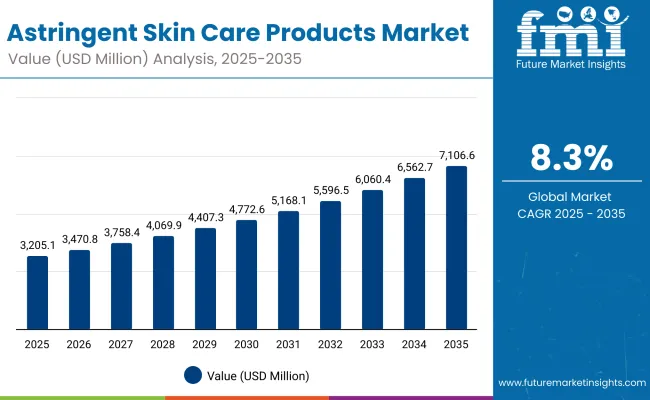
Astringent Skin Care Products Market Key Takeaways
| Metric | Value |
|---|---|
| Astringent Skin Care Products Market Estimated Value (2025E) | USD 3,205.1 million |
| Astringent Skin Care Products Market Forecast Value (2035F) | USD 7,106.6 million |
| Forecast CAGR (2025 to 2035) | 8.3% |
During the first five-year period from 2025 to 2030, the market increases from USD 3,205.1 million to USD 4,772.6 million, adding USD 1,567.5 million, which accounts for 40% of the total decade growth. This phase records steady adoption in anti-aging and firming skincare, alcohol-based formulations, and witch hazel-based toners, driven by rising consumer awareness and clinical validation. Oily and combination skin formulations dominate this period as they cater to over 50% of applications, supported by expanding e-commerce penetration and dermatologist-backed recommendations.
The second half from 2030 to 2035 contributes USD 2,334.0 million, equal to 60% of total growth, as the market jumps from USD 4,772.6 million to USD 7,106.6 million. This acceleration is powered by AI-integrated personalized skincare tools, digitally tracked consumer engagement, and hybrid astringent formulations combining botanical and alcohol-based ingredients. E-commerce and specialty beauty retail channels together capture a share above 80% by the end of the decade. Data-driven personalization and smart skincare ecosystems add recurring value, increasing the digital sales share beyond 45% of total revenue.
From 2020 to 2024, the Astringent Skin Care Products Market expanded steadily, driven by growing consumer adoption of toners, lotions, and witch hazel-based blends. During this period, the competitive landscape was dominated by heritage skincare brands controlling nearly 80% of category revenues, with leaders such as Thayers, Clinique, and Neutrogena focusing on dermatologically tested formulations and online retail presence. Competitive differentiation relied on active ingredient transparency, natural composition, and dermatologist endorsement, while private labels had limited penetration in premium retail formats. Service-led brand engagement contributed modestly, representing less than 10% of the total value through online skin consultation programs.
Demand for astringent skincare products is projected to reach USD 3,205.1 million in 2025, and the revenue mix is expected to shift toward digital retail channels and hybrid formulations. Traditional cosmetic leaders face competition from digital-first and clean beauty brands emphasizing botanical actives and sustainability certifications. Major incumbents are pivoting toward AI-integrated skin analysis, personalized recommendation platforms, and subscription-based replenishment models to retain consumer loyalty. The competitive advantage is evolving from ingredient innovation alone to ecosystem-led brand engagement, omnichannel accessibility, and recurring digital interactions.
The market is witnessing strong growth as consumers increasingly seek effective oil-control and pore-tightening formulations, particularly among those with combination and acne-prone skin. The preference for astringents with natural ingredients such as witch hazel and alcohol-free variants has expanded their use across daily skincare routines. This trend is further reinforced by the rising humidity levels in urban environments, increased awareness of skin hygiene, and a shift toward lightweight, fast-absorbing toners and lotions suitable for all skin types.
E-commerce and specialty beauty retail platforms have transformed product accessibility, driving the adoption of astringent skincare products worldwide. Brands now leverage targeted digital marketing, influencer collaborations, and subscription models to reach younger demographics. The premiumization of skincare through clinical-grade and dermatologist-endorsed formulations has also accelerated consumer interest. As online product trials, reviews, and AI-based skin assessment tools become widespread, consumers are making more informed purchases, boosting sales across both developed and emerging markets.
The market is segmented by product type, key ingredients, skin concern, distribution channel, end user, and region. Product types include toners, lotions, pads & wipes, and serums, forming the primary product categories driving consumer adoption. By key ingredients, segmentation covers witch hazel, alcohol-based blends, salicylic acid, and alum, representing the functional actives responsible for pore tightening and oil regulation. Based on skin concern, the categories include oily/combination skin, acne-prone skin, and post-shave skin tightening, reflecting diverse dermatological needs.
Distribution channels encompass e-commerce, pharmacies/drugstores, specialty beauty retail, and supermarkets, addressing varying consumer access preferences. End-user segments include women, men, teens, and unisex, capturing broad demographic coverage across skin types and lifestyles. Regionally, the market spans North America, Europe, East Asia, South Asia & Pacific, Latin America, and the Middle East & Africa, providing insights into regional consumption trends, growth trajectories, and evolving brand competitiveness.
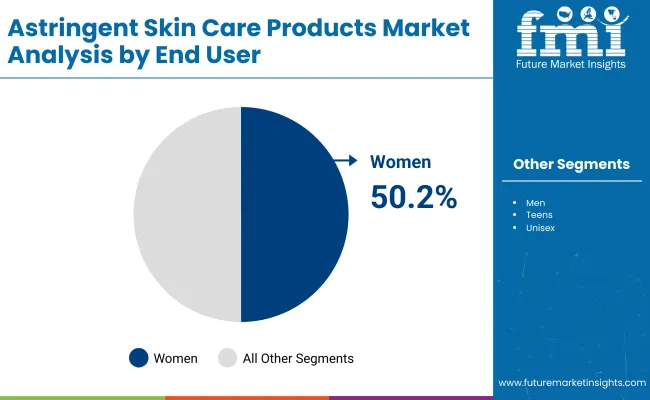
| End User | Value Share% 2025 |
|---|---|
| Anti-aging & firming | 50.2% |
| Others | 49.8% |
The anti-aging and firming segment dominates the Astringent Skin Care Products Market with a 50.2% value share in 2025, reflecting strong consumer focus on preventive skincare and age-defying benefits. This dominance is driven by growing demand among middle-aged and mature consumers for products that improve skin elasticity, tone, and firmness. Astringent formulations targeting collagen support, skin tightening, and texture refinement have seen increased adoption in both premium and mass-market categories.
The others segment, representing 49.8%, includes general-purpose and youth-oriented skincare users, where emphasis lies on oil control and daily cleansing. While nearly equal in size, the anti-aging and firming category is expanding faster due to technological advances in formulation such as peptide-infused and botanical-based astringents. Brands are positioning these products as part of comprehensive anti-aging regimens, combining toners and firming lotions. This segment is expected to remain the market’s key value driver, supported by continued innovation and rising disposable incomes among aging populations.
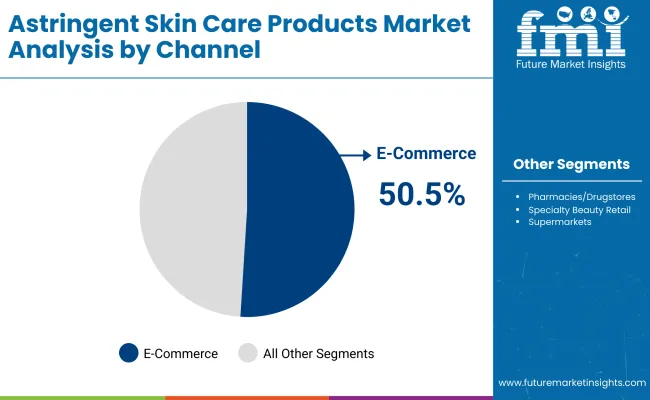
| Channel | Value Share% 2025 |
|---|---|
| E-commerce | 50.5% |
| Others | 49.5% |
The e-commerce segment is forecasted to hold 50.5% of the Astringent Skin Care Products Market share in 2025, driven by rising online skincare purchases and the growing influence of digital beauty platforms. Consumers are increasingly turning to online channels for convenience, product variety, and personalized recommendations through AI-powered skin analysis tools. Global beauty marketplaces and brand-owned e-stores have expanded accessibility, enabling targeted marketing and subscription-based skincare plans.
The segment’s growth is reinforced by enhanced logistics networks, promotional campaigns, and influencer-driven content that foster brand loyalty. Meanwhile, the offline channel, accounting for 49.5%, continues to play a vital role through pharmacies, department stores, and dermatology clinics offering in-person consultations. However, as digital adoption deepens and consumer trust in online authenticity improves, e-commerce is expected to remain the dominant distribution channel for astringent skincare products through 2035.
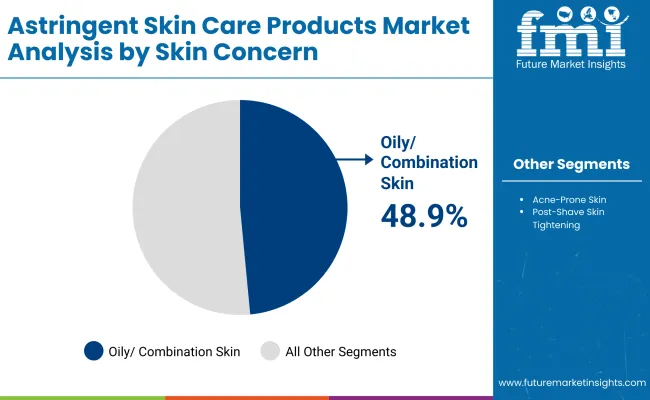
| Skin Concern | Value Share% 2025 |
|---|---|
| Oily/combination skin | 48.9% |
| Others | 51.1% |
The oily and combination skin segment is projected to account for 48.9% of the Astringent Skin Care Products Market revenue in 2025, establishing it as a key demand driver. This segment’s growth is propelled by increasing consumer awareness regarding excess sebum control, pore tightening, and breakout prevention concerns prevalent among younger demographics and urban populations exposed to pollution and humidity. Astringent formulations, particularly toners and lotions, are designed to balance oil production while maintaining hydration, making them essential in daily skincare routines.
The others segment, representing 51.1%, includes sensitive, normal, and dry skin types that rely on mild astringents for post-cleansing refinement. However, innovation in hybrid formulations combining botanical extracts with alcohol-free, pH-balanced bases is expanding the oily/combination skin category’s appeal. With growing product personalization, digital skin-type mapping, and rising male grooming awareness, the oily/combination skin segment is expected to maintain a strong trajectory through 2035.
Growing Preference for Natural and Botanical Formulations
The market is witnessing robust growth as consumers increasingly prefer natural, plant-based ingredients such as witch hazel, aloe vera, and tea tree extract in astringent skincare products. The shift away from alcohol-heavy formulations toward gentler, dermatologist-tested alternatives aligns with the clean beauty and sustainability movement. Brands are capitalizing on this by introducing organic, vegan-certified, and paraben-free variants. The growing influence of ingredient transparency, ethical sourcing, and eco-friendly packaging continues to attract health-conscious consumers, driving steady demand across both mass-market and premium skincare segments globally.
Expansion of Digital Retail and Personalized Skincare Platforms
The rapid growth of e-commerce and digital skincare platforms has become a critical growth accelerator for the astringent skincare market. Consumers are increasingly purchasing skincare online, aided by virtual skin assessment tools, AI-based recommendation engines, and influencer marketing. Subscription models and online-exclusive product launches have strengthened brand-customer engagement. This digital shift enables brands to reach wider audiences, particularly in emerging markets, while also leveraging data analytics for personalized marketing. As online product education and trial experiences improve, digital retail will remain a central force driving global market expansion.
Irritation Risks and Sensitivity to Active Ingredients
Despite strong market potential, product adoption faces constraints due to irritation risks linked to certain astringent formulations particularly those containing alcohol and high concentrations of acids. Sensitive and dry-skin consumers often experience redness or tightness, leading to cautious product use or avoidance. Regulatory scrutiny around formulation safety and claims validation is increasing, requiring brands to invest heavily in dermatological testing. The demand for milder, pH-balanced, and alcohol-free alternatives is reshaping product development priorities, but the reputation of harsh astringents still limits penetration in sensitive skincare segments.
Integration of AI and Smart Diagnostics in Skincare Routines
A growing trend in the market is the integration of AI and smart diagnostic tools into skincare routines, enabling hyper-personalized product recommendations. Consumers now use smartphone-based skin analyzers and connected beauty devices to assess oil levels, pore size, and skin texture before selecting astringent products. Major brands are launching digital skincare ecosystems combining AI analysis with product customization and usage tracking. This technology-driven personalization not only enhances user engagement but also boosts repurchase intent. The trend reflects the convergence of dermatology, data analytics, and skincare innovation reshaping the consumer experience.
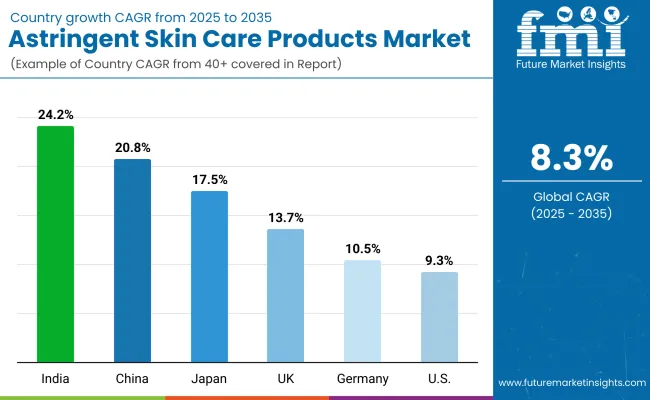
| Countries | Estimated CAGR (2025 to 2035) |
|---|---|
| China | 20.8% |
| USA | 9.3% |
| India | 24.2% |
| UK | 13.7% |
| Germany | 10.5% |
| Japan | 17.5% |
The global Astringent Skin Care Products Market exhibits distinct regional growth patterns shaped by consumer behavior, retail modernization, and skincare innovation trends. Asia-Pacific leads global expansion, driven by India (24.2%) and China (20.8%), supported by rising disposable incomes, rapid urbanization, and growing male grooming awareness. China’s strong demand for natural and alcohol-free toners, coupled with the proliferation of digital-first beauty brands, fuels aggressive market expansion. India’s surge reflects increased adoption of astringent products among millennials, supported by influencer marketing and domestic D2C skincare startups emphasizing herbal formulations.
Japan (17.5%) maintains a solid trajectory, supported by a culture of skincare precision and a growing anti-aging product base targeting mature consumers. Europe sustains consistent momentum led by the UK (13.7%) and Germany (10.5%), where premium skincare adoption and dermatologist-backed formulations dominate. These markets emphasize ingredient transparency and sustainability certifications, aligning with EU cosmetic compliance standards. In North America, the USA (9.3%) shows moderate but steady growth driven by demand for multifunctional skincare, AI-assisted product personalization, and expanding online distribution networks. Overall, Asia-Pacific remains the primary growth engine, expected to account for the majority of global value gains through 2035.
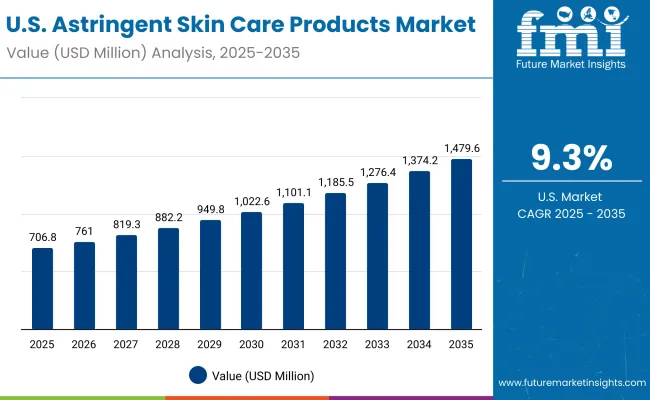
| Year | USA Astringent Skin Care Products Market (USD Million) |
|---|---|
| 2025 | 706.8 |
| 2026 | 761.0 |
| 2027 | 819.3 |
| 2028 | 882.2 |
| 2029 | 949.8 |
| 2030 | 1022.6 |
| 2031 | 1101.1 |
| 2032 | 1185.5 |
| 2033 | 1276.4 |
| 2034 | 1374.2 |
| 2035 | 1479.6 |
The Astringent Skin Care Products Market in the United States is projected to expand at a CAGR of 8.4% from 2025 to 2035, reflecting consistent growth across both premium and mass skincare segments. Demand is being driven by rising consumer focus on oil-control, anti-aging, and pore-minimizing solutions, particularly within dermatology-endorsed formulations. The proliferation of e-commerce platforms and omnichannel retail strategies has improved accessibility, while AI-based skincare tools are enhancing personalized product selection.
The USA market is also witnessing a notable shift toward alcohol-free and natural formulations, supported by dermatological awareness and clean-beauty preferences. Increasing male grooming participation and the popularity of multifunctional toners further strengthen product demand. Major brands are leveraging data-driven marketing and subscription-based sales models to sustain repeat purchases.
The Astringent Skin Care Products Market in the United Kingdom is projected to grow at a CAGR of 13.7% from 2025 to 2035, driven by the strong consumer shift toward natural, dermatologist-tested, and clinically validated skincare solutions. Rising awareness of anti-aging and pore-refining benefits has expanded product use among both women and men, particularly within urban populations. The premium skincare segment continues to flourish, supported by high adoption across pharmacy chains, department stores, and specialist beauty retailers.
Digital innovation is accelerating market expansion as brands integrate AI-based skin diagnostics, virtual consultations, and AR try-on technologies to enhance product personalization. The United Kingdom’s well-established regulatory standards and sustainable sourcing initiatives are encouraging clean-label formulations and eco-conscious packaging practices. Supported by strong R&D collaboration between skincare laboratories and dermatological institutions, the market is positioned for long-term growth.
India is emerging as one of the fastest-growing markets for astringent skincare products, projected to expand at a CAGR of 24.2% through 2035. The country’s growth is propelled by a young consumer base, rising disposable incomes, and heightened awareness of skincare hygiene and oil-control routines. Tier-2 and tier-3 cities are showing exceptional adoption, supported by affordable product launches, localized e-commerce campaigns, and influencer-driven digital marketing. Domestic and international brands are leveraging Ayurveda-inspired formulations to blend traditional ingredients with modern skincare benefits, enhancing consumer trust.
Rapid urbanization and exposure to pollution are driving the need for daily-use toners, lotions, and wipes, especially among millennials and working professionals. Increasing male participation in skincare routines and growth in unisex product categories are also contributing to demand expansion. Local manufacturing and digital-first distribution have strengthened product accessibility, while sustainable, alcohol-free innovations continue to appeal to health-conscious consumers.
The Astringent Skin Care Products Market in China is projected to grow at a CAGR of 20.8% from 2025 to 2035, the fastest among all major economies. This rapid expansion is driven by the country’s growing middle-class population, increasing skincare awareness, and widespread adoption of alcohol-free and herbal-based formulations. Domestic beauty brands are innovating aggressively with botanical astringents, niacinamide-infused toners, and skin-brightening lotions, aligning with consumer preferences for multifunctional skincare. E-commerce giants and social commerce platforms such as Tmall, Douyin, and Xiaohongshu are fueling explosive online sales through influencer-driven campaigns and live-stream retailing.
China’s market leadership is also supported by advanced manufacturing ecosystems, digital retail integration, and strong government support for local cosmetic R&D and export-oriented production. Affordable yet premium-quality domestic brands are gaining share from international competitors through rapid product launches and ingredient transparency.
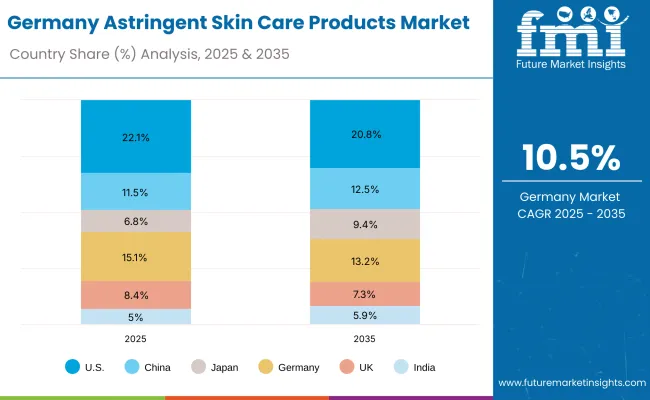
| Countries | 2025 Share (%) |
|---|---|
| USA | 22.1% |
| China | 11.5% |
| Japan | 6.8% |
| Germany | 15.1% |
| UK | 8.4% |
| India | 5.0% |
| Countries | 2035 Share (%) |
|---|---|
| USA | 20.8% |
| China | 12.5% |
| Japan | 9.4% |
| Germany | 13.2% |
| UK | 7.3% |
| India | 5.9% |
The Astringent Skin Care Products Market in Germany is expected to grow at a CAGR of 10.5% from 2025 to 2035, supported by a strong preference for dermatologically tested, sustainable, and ingredient-transparent formulations. Germany’s skincare consumers are highly educated and quality-driven, favoring products backed by clinical efficacy and eco-certifications. While the country’s global market share is projected to decline slightly from 15.1% in 2025 to 13.2% in 2035, the market’s value base will continue to expand steadily, fueled by innovation and rising male participation in skincare.
Leading German and European skincare brands are emphasizing alcohol-free astringents, pH-balanced toners, and vegan-certified formulations, aligning with EU clean beauty regulations. The demand for anti-aging and firming astringents is particularly strong among middle-aged consumers seeking pore refinement and skin-tightening benefits. The country’s robust pharmacy network and growing digital retail penetration are also contributing to market expansion.
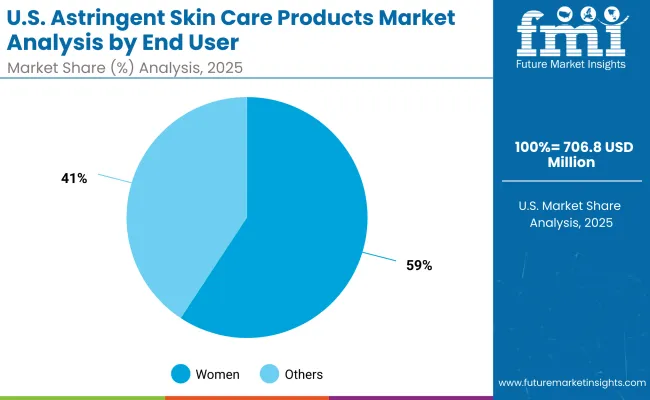
| USA by End User | Value Share% 2025 |
|---|---|
| Women | 59.3% |
| Others | 40.7% |
The Astringent Skin Care Products Market in the United States is projected to reach USD 706.8 million in 2025, driven primarily by strong demand from women, who account for nearly 59.3% of market revenue. The segment’s dominance is attributed to a growing focus on anti-aging, pore-refining, and skin-firming routines, alongside a preference for alcohol-free and dermatologist-tested toners. The "others" category, comprising men and unisex consumers, represents 40.7%, with notable growth supported by the expanding male grooming and gender-neutral skincare movements.
Digital transformation is reshaping the USA skincare landscape, as brands leverage AI-driven skin analysis, subscription-based refills, and virtual consultation tools to enhance personalization and retention. The trend toward clean-label and cruelty-free formulations continues to drive purchasing decisions, particularly among younger, eco-conscious consumers. With the rise of influencer marketing, omnichannel sales, and product innovation across premium and mass categories, the USA market is positioned for sustained, innovation-led growth through 2035.
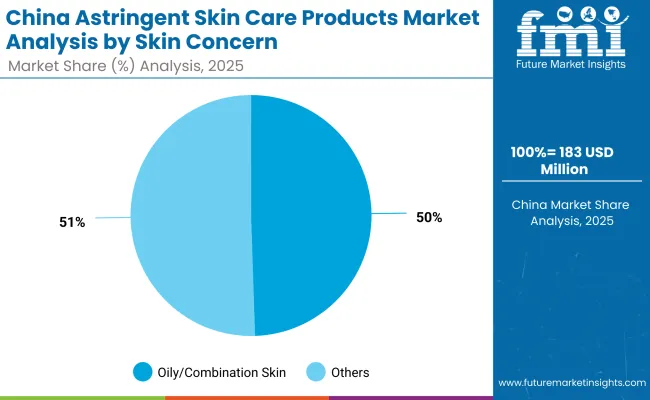
| China by Skin Concern | Value Share% 2025 |
|---|---|
| Oily/combination skin | 49.5% |
| Others | 50.5% |
The Astringent Skin Care Products Market in China presents strong growth opportunities driven by the country’s evolving skincare culture, digital retail dominance, and rising consumer focus on oil control and skin clarity. The oily and combination skin segment, representing 49.5% of market share in 2025, is expanding rapidly due to climatic factors, pollution exposure, and lifestyle-induced skin concerns common in major cities such as Shanghai, Beijing, and Guangzhou. Brands are responding with lightweight, alcohol-free, and botanical-based astringents designed for daily use, often marketed under the clean beauty and "skin health" positioning.
The others segment (50.5%), encompassing sensitive, normal, and mature skin consumers, offers opportunities for growth through pH-balanced, moisturizing astringents and anti-aging toners. Chinese consumers’ increasing reliance on AI-powered beauty apps and social-commerce platforms for personalized recommendations is also redefining product discovery. Domestic brands are gaining significant traction through affordable innovation, influencer partnerships, and sustainably packaged skincare.
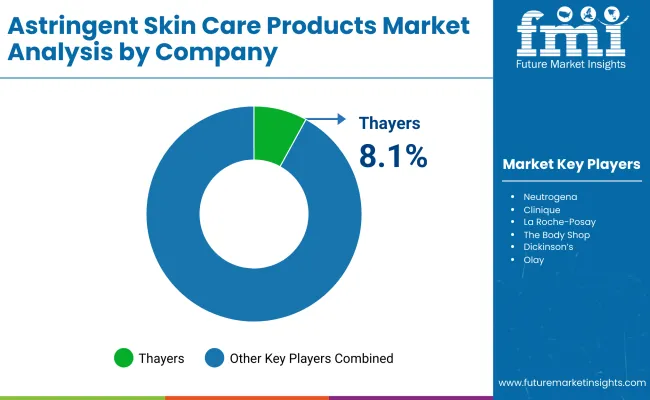
The Astringent Skin Care Products Market is moderately fragmented, characterized by the presence of global heritage brands, emerging digital-first entrants, and niche clean-beauty innovators competing across multiple price tiers. Thayers, with an 8.1% global market share in 2025, leads the category through its strong brand legacy, extensive retail distribution, and dominance in witch hazel-based formulations. The company’s positioning in the natural skincare segment continues to anchor its market leadership in North America and beyond.
Other major players Neutrogena, Clinique, La Roche-Posay, The Body Shop, Olay, Kiehl’s, and Paula’s Choicecollectively account for a significant portion of global revenue, focusing on dermatologist-endorsed, alcohol-free, and pH-balanced astringents. These brands leverage omnichannel retail networks, AI-powered skin analysis, and personalized digital marketing to strengthen consumer loyalty.
The remaining 91.9% of market value is distributed among regional brands and clean-beauty startups emphasizing sustainability, transparency, and plant-derived actives. Their agility in formulation innovation and localized digital campaigns enhances competitiveness against multinational incumbents.
Competitive differentiation is shifting from traditional formulation claims to ecosystem-driven strategies, including AI-based skincare diagnostics, subscription-based product replenishment, and eco-responsible packaging solutions. The long-term advantage will rest with brands that combine scientific validation, digital engagement, and sustainable sourcing to build enduring consumer trust.
Key Developments in Astringent Skin Care Products Market
| Item | Value |
|---|---|
| Quantitative Units | USD 3,205.1 Million |
| Product Type | Toners, Lotions, Pads & wipes, Serums |
| Key Ingredients | Witch hazel, Alcohol-based blends, Salicylic acid, Alum |
| Skin Concern | Oily/combination skin, Acne-prone skin, Post-shave skin tightening |
| Channel | E-commerce, Pharmacies/drugstores, Specialty beauty retail, Supermarkets |
| End User | Women, Men, Teens, Unisex |
| Regions Covered | North America, Europe, Asia-Pacific, Latin America, Middle East & Africa |
| Country Covered | United States, Canada, Germany, France, United Kingdom, China, Japan, India, Brazil, South Africa |
| Key Companies Profiled | Thayers, Neutrogena, Clinique, La Roche-Posay, The Body Shop, Dickinson’s, Olay, Kiehl’s, Paula’s Choice, Witch |
| Additional Attributes | Dollar sales by product type and skin concern category, adoption trends in anti-aging and oil-control skincare routines, rising demand for alcohol-free and botanical-based formulations, segment-specific growth across women’s, men’s, and unisex skincare lines, revenue analysis by e-commerce and specialty beauty retail channels, integration of AI-based skin diagnostics and personalized product recommendation platforms, regional trends shaped by digital beauty retail and influencer marketing, and innovations in formulation science including pH-balanced, witch hazel, and salicylic acid-based astringents. |
The global Astringent Skin Care Products Market is estimated to be valued at USD 3,205.1 million in 2025.
The market size for the Astringent Skin Care Products Market is projected to reach USD 7,106.6 million by 2035.
The Astringent Skin Care Products Market is expected to grow at 8.3% CAGR between 2025 and 2035.
The key product types in the Astringent Skin Care Products Market are toners, lotions, pads & wipes, and serums.
In terms of channel reach, the e-commerce segment is expected to command a significant share in the Astringent Skin Care Products Market in 2025, driven by rising online skincare purchases, digital beauty consultations, and influencer-led product promotion.






Our Research Products

The "Full Research Suite" delivers actionable market intel, deep dives on markets or technologies, so clients act faster, cut risk, and unlock growth.

The Leaderboard benchmarks and ranks top vendors, classifying them as Established Leaders, Leading Challengers, or Disruptors & Challengers.

Locates where complements amplify value and substitutes erode it, forecasting net impact by horizon

We deliver granular, decision-grade intel: market sizing, 5-year forecasts, pricing, adoption, usage, revenue, and operational KPIs—plus competitor tracking, regulation, and value chains—across 60 countries broadly.

Spot the shifts before they hit your P&L. We track inflection points, adoption curves, pricing moves, and ecosystem plays to show where demand is heading, why it is changing, and what to do next across high-growth markets and disruptive tech

Real-time reads of user behavior. We track shifting priorities, perceptions of today’s and next-gen services, and provider experience, then pace how fast tech moves from trial to adoption, blending buyer, consumer, and channel inputs with social signals (#WhySwitch, #UX).

Partner with our analyst team to build a custom report designed around your business priorities. From analysing market trends to assessing competitors or crafting bespoke datasets, we tailor insights to your needs.
Supplier Intelligence
Discovery & Profiling
Capacity & Footprint
Performance & Risk
Compliance & Governance
Commercial Readiness
Who Supplies Whom
Scorecards & Shortlists
Playbooks & Docs
Category Intelligence
Definition & Scope
Demand & Use Cases
Cost Drivers
Market Structure
Supply Chain Map
Trade & Policy
Operating Norms
Deliverables
Buyer Intelligence
Account Basics
Spend & Scope
Procurement Model
Vendor Requirements
Terms & Policies
Entry Strategy
Pain Points & Triggers
Outputs
Pricing Analysis
Benchmarks
Trends
Should-Cost
Indexation
Landed Cost
Commercial Terms
Deliverables
Brand Analysis
Positioning & Value Prop
Share & Presence
Customer Evidence
Go-to-Market
Digital & Reputation
Compliance & Trust
KPIs & Gaps
Outputs
Full Research Suite comprises of:
Market outlook & trends analysis
Interviews & case studies
Strategic recommendations
Vendor profiles & capabilities analysis
5-year forecasts
8 regions and 60+ country-level data splits
Market segment data splits
12 months of continuous data updates
DELIVERED AS:
PDF EXCEL ONLINE
Skincare Products Market Size and Share Forecast Outlook 2025 to 2035
Men’s Skincare Products Market Size, Growth, and Forecast for 2025 to 2035
Buffering Skincare Products Market Analysis - Size and Share Forecast Outlook 2025 to 2035
Tea-Based Skin Care Products Market Analysis by Product Type, Tea Type, Skin Type, Sales Channel and Region from 2025 to 2035
Dispersing Skin Care Products Market Size and Share Forecast Outlook 2025 to 2035
Lubricating Skin Care Products Market Analysis - Size and Share Forecast Outlook 2025 to 2035
Moisturizing Skincare Products Market Size and Share Forecast Outlook 2025 to 2035
Anti-Fatigue Skincare Products Market Size and Share Forecast Outlook 2025 to 2035
Incontinence Skincare Products Market Analysis by Product Type, Price, End-User, Sales Channel and Region 2025 to 2035
Anti-Pollution Skin Care Products Market Trends - Growth & Forecast 2025 to 2035
Anti-Inflammatory Skincare Products Market Size and Share Forecast Outlook 2025 to 2035
Allantoin Extract for Skincare Products Market Analysis – Trends, Growth & Forecast 2025 to 2035
Skincare Supplement Market Size and Share Forecast Outlook 2025 to 2035
Skincare Oil Market Size and Share Forecast Outlook 2025 to 2035
Skincare Nutritional Serum Market Size and Share Forecast Outlook 2025 to 2035
Skincare Market Analysis - Size, Share, and Forecast Outlook 2025 to 2035
Skincare Packaging Market Size, Share & Forecast 2025 to 2035
Skincare Industry in India – Trends & Growth Forecast 2024-2034
Global Skincare Treatment Market Analysis – Size, Share & Forecast 2024-2034
Skin Care Devices Market Analysis - Trends & Forecast 2025 to 2035

Thank you!
You will receive an email from our Business Development Manager. Please be sure to check your SPAM/JUNK folder too.
Chat With
MaRIA